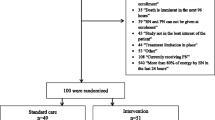Abstract
Objectives
To compare the time taken to reach the target calories and proteins by protocol based “continuous tube feeding (CTF)” and “intermittent tube feeding (ITF)” in critically ill children.
Methods
This trial was conducted in the Pediatric Intensive Care Unit (PICU) of a tertiary care institute. Eligible children were randomized to receive CTF or ITF. Target calories were defined as 70% of calorie amount as per the WHO formula and target protein was defined as 1.5 g/kg as per the American Society of Parenteral and Enteral Nutrition (ASPEN) criteria. The primary outcome was time taken to reach target calories, the secondary outcomes were time taken to reach target protein, incidence of feed intolerance, PICU mortality, duration of ventilation, and outcome on 28th day.
Results
Fifty-eight children were randomized; 29 in each group. The baseline characters were comparable. The median (IQR) times for reaching target calories were 1.7 (1.4, 2.5) d and 1.8 (1.4, 4.4) d in the CTF and ITF groups, respectively [Hazards ratio (HR) 0.89 (95% CI 0.5, 1.5); p = 0.69]. For the target protein intake, the median times were comparable in the 2 groups [HR 0.82 (95% CI 0.4-1.5); p = 0.55]. The other outcomes were not significantly different between the groups.
Conclusions
The authors did not observe any difference in the time taken to reach target calories and protein between the two different modes of delivery of enteral nutrition.

Similar content being viewed by others
References
Mehta NM, Bechard LJ, Cahill N, et al. Nutritional practices and their relationship to clinical outcomes in critically ill children–an international multicenter cohort study. Crit Care Med. 2012;40:2204–11.
Bechard LJ, Duggan C, Touger-Decker R, et al. Nutritional status based on body mass index is associated with morbidity and mortality in mechanically ventilated critically ill children in the PICU. Crit Care Med. 2016;44:1530–7.
Bagri NK, Jose B, Shah SK, Bhutia TD, Kabra SK, Lodha R. Impact of malnutrition on the outcome of critically ill children. Indian J Pediatr. 2015;82:601–5.
Mehta NM, Skillman HE, Irving SY, et al. Guidelines for the provision and assessment of nutrition support therapy in the pediatric critically ill patient: Society of Critical Care Medicine and American Society for Parenteral and Enteral Nutrition. JPEN J Parenter Enteral Nutr. 2017;41:706–42.
Brown AM, Fisher E, Forbes ML. Bolus vs continuous nasogastric feeds in mechanically ventilated pediatric patients: a pilot study. JPEN J Parenter Enteral Nutr. 2019;43:750–8.
Fayazi S, Adineh M, Fard SZ, Payam HF, Batvandy ZA. Comparing two methods of enteral nutrition in terms of their complications and the time needed to reach goal calorie in children hospitalized in ICU. Int J Pediatr. 2016;4:2119–30.
Brown AM, Madsen EC, Leonard CP, et al. Continuous versus bolus gastric feeding in children receiving mechanical ventilation: a systematic review. Am J Crit Care. 2020;29:33–45.
Tume LN, Valla FV. A review of feeding intolerance in critically ill children. Eur J Pediatr. 2018;177:1675–83.
Jotterand Chaparro C, Moullet C, Taffé P, et al. Estimation of resting energy expenditure using predictive equations in critically ill children: results of a systematic review. JPEN J Parenter Enteral Nutr. 2018;42:976–86.
Agus MSD, Wypij D, Hirshberg EL, et al. HALF-PINT Study Investigators and the PALISI Network. Tight glycemic control in critically ill children. N Engl J Med. 2017;376:729–41.
Straney L, Clements A, Parslow RC, et al. ANZICS Paediatric Study Group and the Paediatric Intensive Care Audit Network. Paediatric index of mortality 3: an updated model for predicting mortality in pediatric intensive care. Pediatr Crit Care Med. 2013;14:673-81.
WHO Multicentre Growth Reference Study Group. WHO child growth standards based on length/height, weight and age. Acta Paediatr Suppl. 2006;450:76–85.
Indian Academy of Pediatrics Growth Charts Committee; Khadilkar V, Yadav S, Agrawal KK, et al. Revised IAP growth charts for height, weight and body mass index for 5- to 18-year-old Indian children. Indian Pediatr. 2015;52:47–55.
Leteurtre S, Duhamel A, Salleron J, Grandbastien Bruno, Lacroix Jacques, Leclerc Francis; Groupe Francophone de Réanimation et d’Urgences Pédiatriques (GFRUP). PELOD-2: an update of the PEdiatric logistic organ dysfunction score. Crit Care Med. 2013;41:1761–73.
Matics TJ, Sanchez-Pinto LN. Adaptation and validation of a pediatric sequential organ failure assessment score and evaluation of the sepsis-3 definitions in critically ill children. JAMA Pediatr. 2017;171:e172352.
Martinez EE, Bechard LJ, Brown AM, et al. Intermittent versus continuous enteral nutrition in critically ill children: a pre-planned secondary analysis of an international prospective cohort study. Clin Nutr. 2022;41:2621–7.
Author information
Authors and Affiliations
Contributions
VK: Conceptualization, conduct of the study, data collection, analysis and manuscript writing. JS, MJ, KRJ, SKK: Planning and supervision of the study, and critical inputs for the manuscript. RL: Conceptualization, planning, analysis and manuscript writing. RL will act as guarantor for this manuscript.
Corresponding author
Ethics declarations
Conflict of Interest
None.
Additional information
Publisher's Note
Springer Nature remains neutral with regard to jurisdictional claims in published maps and institutional affiliations.
Supplementary Information
Below is the link to the electronic supplementary material.
Rights and permissions
Springer Nature or its licensor (e.g. a society or other partner) holds exclusive rights to this article under a publishing agreement with the author(s) or other rightsholder(s); author self-archiving of the accepted manuscript version of this article is solely governed by the terms of such publishing agreement and applicable law.
About this article
Cite this article
Kumar, V., Sankar, J., Jana, M. et al. Comparison of Protocol-Based Continuous and Intermittent Tube Feeding in Mechanically Ventilated Critically Ill Children – An Open Label Randomized Controlled Trial. Indian J Pediatr (2023). https://doi.org/10.1007/s12098-023-04941-x
Received:
Accepted:
Published:
DOI: https://doi.org/10.1007/s12098-023-04941-x




